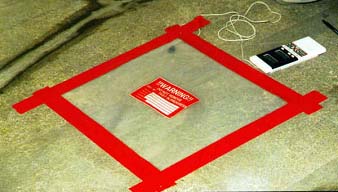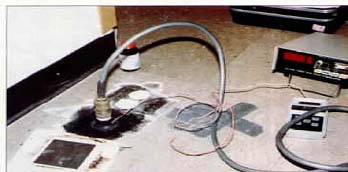Hygrometer
[su_spacer]
Test Procedures

Figure 1: Hygrometer placed under the polythene sheet to record the relative humidity.
- A transparent polythene sheet is tightly taped to the concrete (Figure 1), it is taped around the edges to seal it.(ASTM D4263 “Standard Test Method for Indicating Moisture in Concrete by the Plastic Sheet Method”)
- The sheet should be installed when the ambient conditions are about the same as expected during system installation.
- A label is placed on the plastic sheet. The starting date, time, ambient temperature and relative humidity are recorded on the label.
- After 72 hours, a dew point hygrometer is quickly inserted under one corner of the plastic sheet.
- The hygrometer should be calibrated before use; this may be carried out by placing the hygrometer over a saturated sodium chloride (salt) solution in a desiccator for 12 hours. The instrument should then be adjusted to 75%.
- The relative humidity under the plastic sheet is recorded and the plastic sheet removed.
- If there is visible moisture collects on the underside of the sheeting, it indicated that there is too much moisture inside the concrete.

Several methods are available for measuring the internal moisture content of concrete in service. Here, a dew point hygrometer is being used to measure the relative humidity of a concrete slab covered with floor tiles. Problems can occur in the slab if its internal relative humidity exceeds 50% to 55%.
- A relative humidity under the plastic sheet of 79%, or lower, is required for the successful application of flooring or related materials.